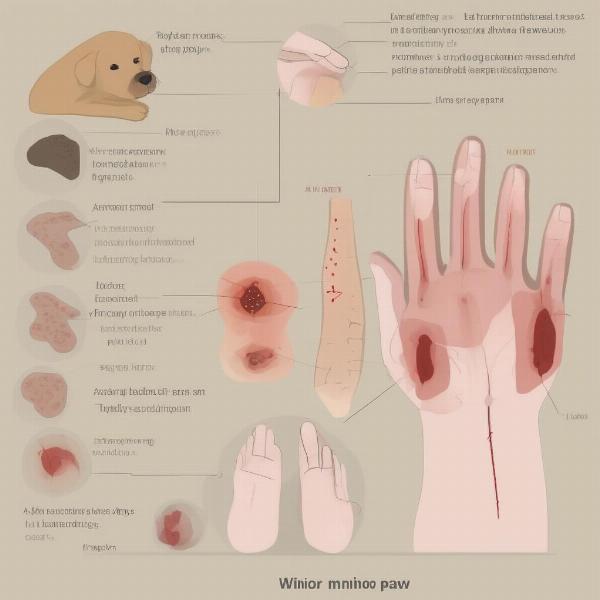A cut on a dog’s paw can be a painful and worrisome experience for both the dog and its owner. Understanding how to properly treat and prevent these injuries is crucial for maintaining your dog’s health and well-being. This guide will provide you with practical advice on identifying, treating, and preventing cuts on your dog’s paws, covering everything from basic first aid to advanced care.
Identifying the Severity of the Cut
Before you begin treating a cut on your dog’s paw, it’s important to assess the severity of the injury. A superficial scrape might only require basic cleaning, while a deep laceration will necessitate a visit to the veterinarian.
- Minor cuts and scrapes: These are often characterized by superficial damage to the skin, with minimal bleeding.
- Deep lacerations: These cuts penetrate deeper into the paw pad, often involving significant bleeding and potential damage to underlying tissues.
- Puncture wounds: These are caused by sharp objects like thorns or glass, and can be difficult to clean thoroughly, increasing the risk of infection.
 Types of Cuts on Dog Paws
Types of Cuts on Dog Paws
First Aid for a Cut on Your Dog’s Paw
If your dog has a cut on its paw, the first step is to control the bleeding by applying gentle pressure to the wound with a clean cloth. Once the bleeding has subsided, clean the wound thoroughly with warm water and a mild antiseptic solution.
What if my dog won’t let me touch their paw? It’s natural for a dog to be protective of an injured paw. Speaking calmly and reassuringly can help. You can also try distracting your dog with a treat while you examine and clean the wound.
When to Seek Veterinary Care
While minor cuts can often be treated at home, some injuries require professional veterinary attention. Seek veterinary care if:
- The bleeding is profuse and difficult to control.
- The cut is deep or involves the underlying tissues.
- The wound appears infected (redness, swelling, pus).
- Your dog is showing signs of pain or discomfort.
- The cut is a puncture wound.
Preventing Cuts on Your Dog’s Paws
Preventing paw injuries is crucial for your dog’s overall health. Here are some preventative measures:
- Regularly trim your dog’s nails to prevent them from catching and tearing.
- Check your dog’s paws regularly for any signs of injury or irritation.
- Avoid walking your dog on hot pavement or rough terrain.
- Use paw balm to protect your dog’s paws from extreme weather conditions.
- Keep your yard free of sharp objects like broken glass or thorns.
Caring for a Bandaged Paw
If your veterinarian bandages your dog’s paw, it’s essential to keep the bandage clean and dry. Prevent your dog from licking or chewing the bandage by using an Elizabethan collar.
How often should I change the bandage? Follow your veterinarian’s instructions regarding bandage changes. Typically, bandages need to be changed every few days to prevent infection.
Conclusion
Cuts on dog paws, while common, can be easily managed with proper care and attention. By understanding how to identify the severity of the cut, administer first aid, and implement preventative measures, you can ensure your dog’s paws remain healthy and injury-free. Always consult your veterinarian if you have any concerns about your dog’s paw health.
FAQ
- How can I tell if my dog’s paw cut is infected? Look for signs like redness, swelling, pus, and an unpleasant odor.
- What can I use to clean my dog’s paw cut? Warm water and a mild antiseptic solution are recommended.
- Is it okay to use hydrogen peroxide on a dog’s paw cut? While hydrogen peroxide can disinfect, it can also damage healthy tissue. It’s best to use a veterinarian-recommended antiseptic.
- Can I use Neosporin on my dog’s paw cut? A plain, non-medicated antibiotic ointment can be used, but consult your vet first.
- How long does it take for a dog’s paw cut to heal? Healing time varies depending on the severity of the cut, but minor cuts typically heal within a week or two.
- How can I stop my dog from licking their paw cut? Use an Elizabethan collar or a paw bandage.
- Should I take my dog to the vet for a small cut on their paw? If the cut is superficial and stops bleeding quickly, you can likely treat it at home. However, if you have any concerns, it’s always best to consult a vet.
About ILM Dog
ILM Dog (https://ilmdog.com) is your trusted resource for expert advice on dog care and well-being. We offer comprehensive guides on dog breeds, health, training, nutrition, grooming, and much more. Whether you’re a new dog owner or a seasoned pro, ILM Dog provides valuable insights and practical tips to help you give your furry friend the best possible care. For personalized advice and support, reach out to our team at [email protected] or call us at +44 20-3965-8624.